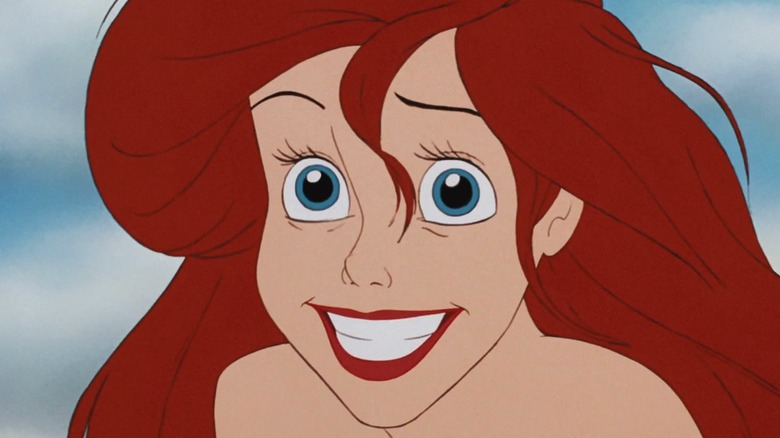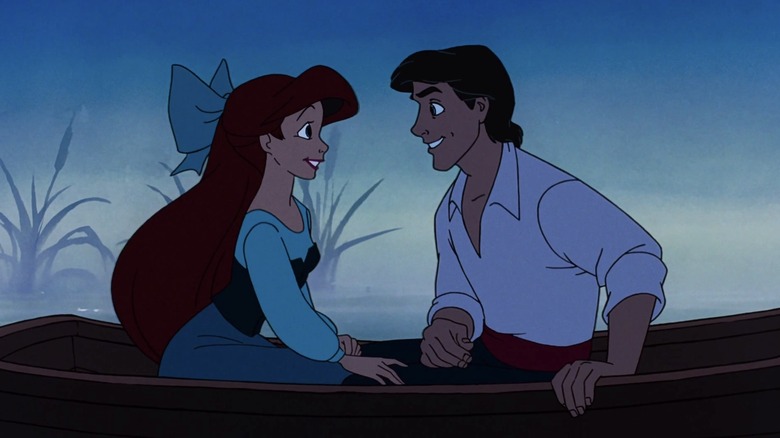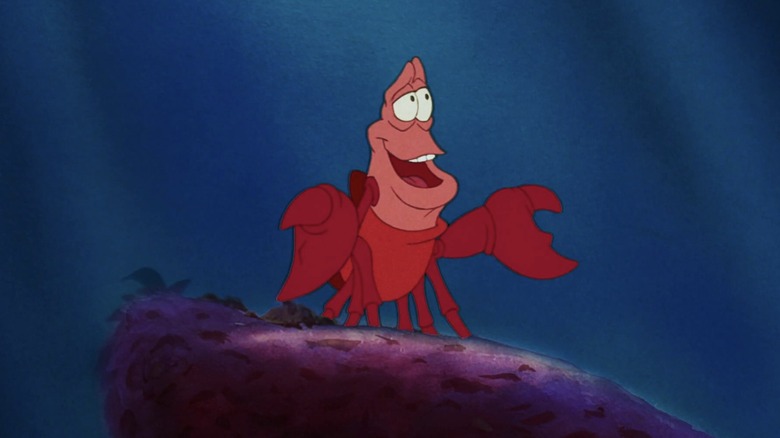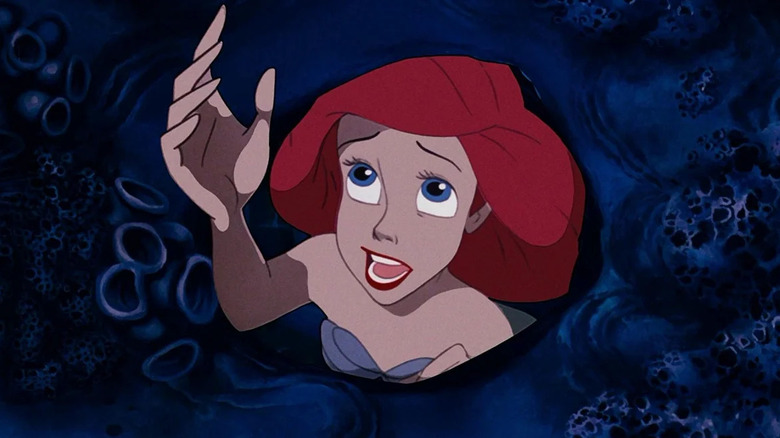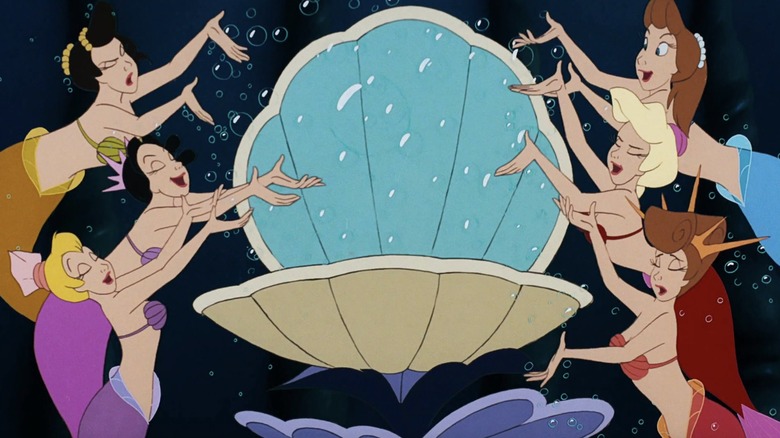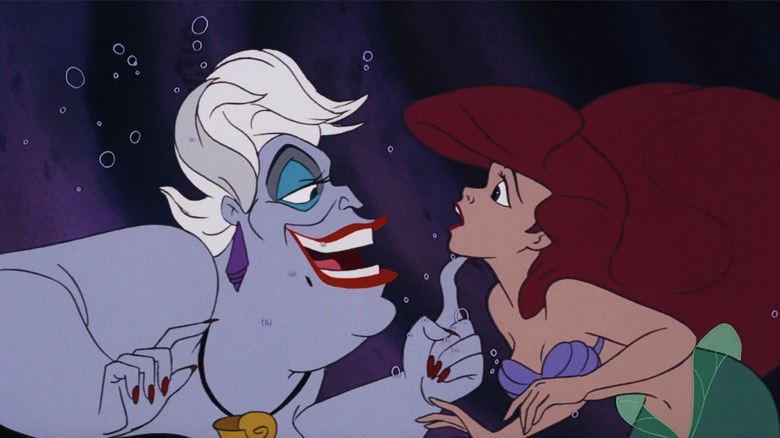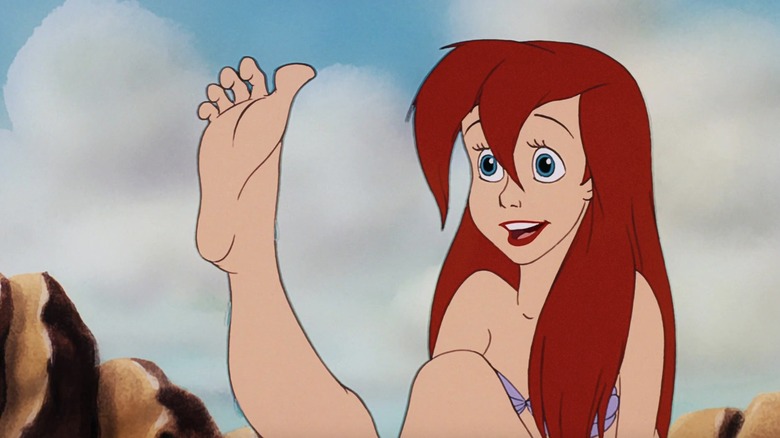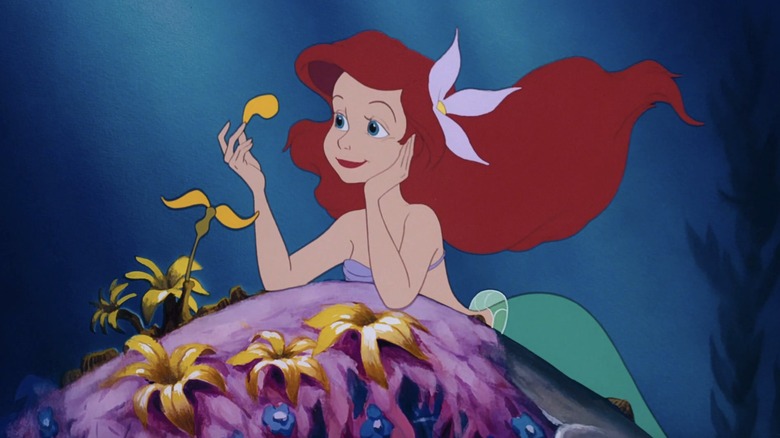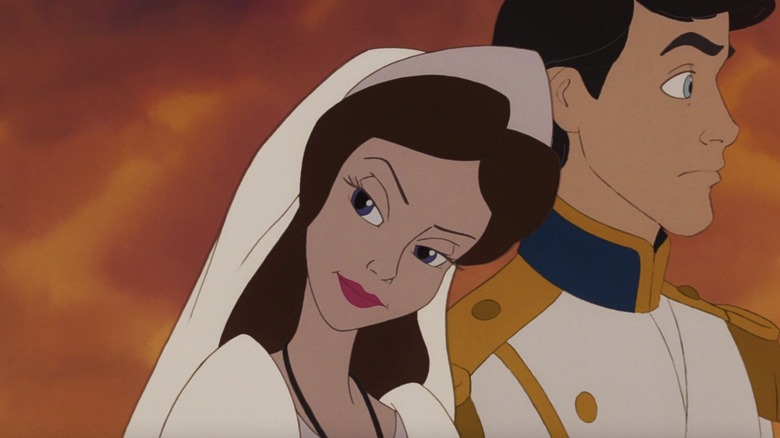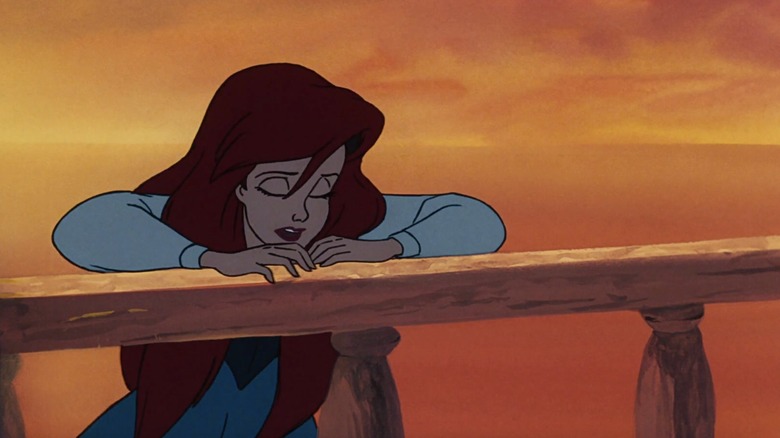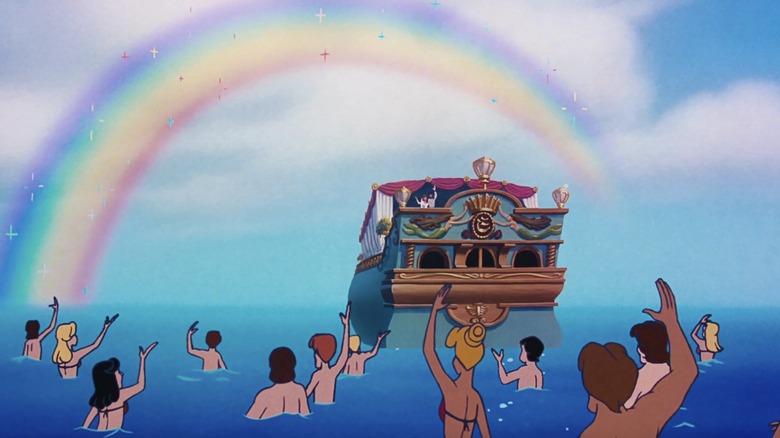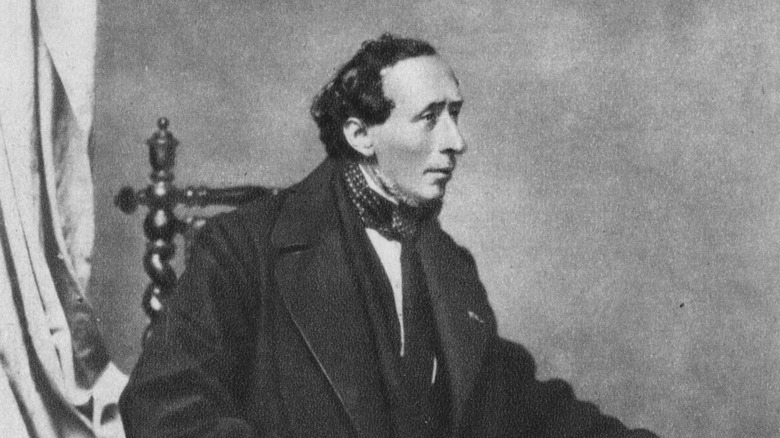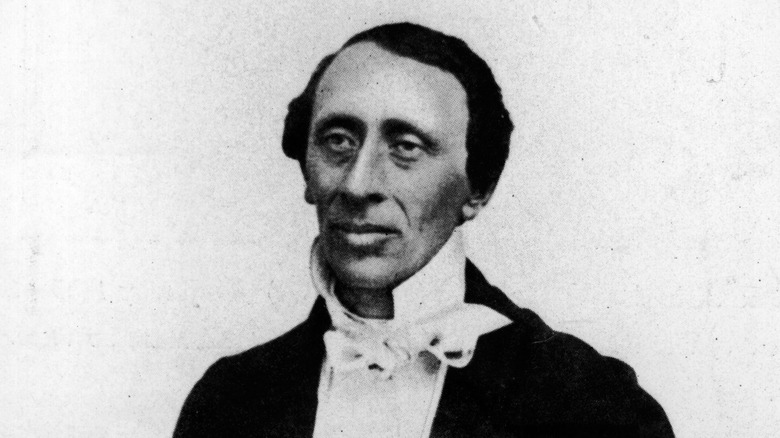The Dark History Of The Little Mermaid
When Disney's "The Little Mermaid" was released in 1989, little girls everywhere fell in love with mermaids, and plenty of other viewers did too. What's not to love about Ariel (Jodi Benson) — a beautiful and strong-willed mythical creature who spends her time collecting treasures, hanging out with her friend Flounder, frolicking under the sea, and singing with that angelic voice? Sebastian (Samuel E. Wright), who was created entirely by Disney, also adds a comic charm to the animated film.
If you've only seen the Disney version of this Hans Christian Andersen fairy tale, though, you don't know the full story. "The Little Mermaid" was first published by the Danish writer in 1837, and while the creatures in the story existed previously in folklore, Andersen's version was an original fairy tale. Some have theorized that the success of Frederick de la Motte Fouque's 1811 novel "Undine," which also follows a mythical water creature, may have encouraged Andersen to explore a more tragic narrative in his own story (per Tor).
Andersen's "The Little Mermaid" is much darker, more gruesome, and heartbreakingly tragic compared to Disney's animated adaptation — a tone that holds true to the style of early fairy tales. Originally, the genre was often frightening, filled with monstrous villains, and absent the trademark Disney happy endings. Let's explore the dark history of "The Little Mermaid."
Ariel doesn't have a name in the original story
In the original "The Little Mermaid," the eponymous protagonist doesn't even have a name. Neither do the Sea Witch (Ursula in the film) or the prince. This is a common fairy tale convention, allowing the characters to better embody their archetypes and hint at the universality of their stories. In the case of "The Little Mermaid," that's a story about seeking love and approval from a place that feels out of reach. However, it's also possible to read a darker meaning into the mermaid's lack of a name — a sign that she's less than a full and autonomous person.
The mermaid being named Ariel in Disney's animated film is indicative of modern storytelling being interested more in personal stories than universal and archetypal allegories. The film even seems to place particular importance on naming things. For instance, there's the hilarious scene where the seagull Scuttle (Buddy Hackett) tells Ariel that a fork is called a dinglehopper and is used as a styling comb or hair pick. There's also the scene where Prince Eric guesses Ariel's name, suggesting in this modern adaptation that Ariel has more agency than Andersen's little mermaid. In the original story, it doesn't seem to especially matter what her name is.
The Disney version leaves out a key character
In Andersen's original story, the Little Mermaid's paternal grandmother teaches and guides her through life after her mother's death. The grandmother is described in the original text as "a clever woman ... an altogether praiseworthy person, particularly so because she was extremely fond of her granddaughters, the little sea princesses." It's the grandmother who tells the princesses when they may visit the surface, explaining that when they turn 15, "you will be allowed to rise up out of the ocean and sit on the rocks in the moonlight, to watch the great ships sailing by."
The little mermaid in Andersen's tale is as adventurous and curious about humans as Ariel is in Disney's animated adaptation. But, unlike Ariel, she abides by the rules of her ocean kingdom despite being impatient, staying below the surface and dreaming of what she'll see when she finally turns 15. In the original story, it's the grandmother who mourns most after the Little Mermaid abandons her family for a life chasing after love on land.
Some have argued that Sebastian serves as a substitute for the grandmother in the Disney adaptation of the story (per Bustle). He certainly has a parental kind of love for Ariel and is one of her most loyal subjects, even accompanying her to Prince Eric's world. Despite the many stellar comedic and musical contributions Sebastian brings to the Disney version, he doesn't carry quite the same emotional power of a grandmother mourning her youngest granddaughter.
Mermaids don't have souls
In Andersen's original tale, the Little Mermaid's grandmother reveals a particularly unsettling piece of lore — mermaids do not have immortal souls. The little mermaid is curious about the human world and constantly asks questions about what humans are like. One day she asks her grandmother if humans die. Her grandmother explains that they die, and that their lives are much shorter than merfolk, but she also includes another grim detail.
In the original text, the grandmother tells the Little Mermaid, "We can live to be three hundred years old, but when we perish we turn into mere foam on the sea ... We have no immortal soul, no life hereafter. We are like the green seaweed — once cut down, it never grows again. Human beings, on the contrary, have a soul which lives forever." The mermaid then learns that the only way she can win a soul and a beautiful afterlife is if a human comes to love her more than anything and marries her. In doing so, he'd share his soul with her.
While in the animated version Ariel is motivated by her love for Prince Eric and her ardent desire to be "where the people are," Andersen's mermaid is largely motivated by a fear of death. She wants a soul and an afterlife in addition to love, and she goes to great lengths to attain them.
The Little Mermaid's five sisters may be sirens
In Disney's "The Little Mermaid," Ariel's sisters are hardly characters, but they're more prominently featured in Andersen's fairy tale. In the original story, all five of the little mermaid's sisters are older than her, so they all get to visit the surface of the ocean before she does. The youngest mermaid princess is so curious about the surface and the world of humans that she asks her sisters about their visits, despite none of them being as interested in the humans as she is.
One passage from Andersen's tale suggests the little mermaid's older sisters are actually sirens who lure sailors to a watery grave. "On many an evening the older sisters would rise to the surface, arm in arm, all five in a row," the author writes. "They had beautiful voices, more charming than those of any mortal beings. When a storm was brewing, and they anticipated a shipwreck, they would swim before the ship and sing most seductively of how beautiful it was at the bottom of the ocean."
As explored by The Greek Reporter, sirens were originally depicted as half-bird, half-woman creatures who sang sailors to their death with their hypnotic voices. But by the Hellenistic period, sirens were often depicted as beautiful women with fish tails instead. The youngest mermaid princess in Andersen's tale has the most beautiful voice of all her sisters, but she doesn't use it for such nefarious purposes.
The Sea Witch takes more than Ariel's voice
As part of the Faustian bargain Ariel makes with Ursula in Disney's "The Little Mermaid," the witch takes the mermaid's voice in exchange for giving her legs. In Andersen's original fairy tale, the Sea Witch says, "You have the sweetest voice of anyone down here at the bottom of the sea, and while I don't doubt that you would like to captivate the Prince with it, you must give this voice to me." Not only does the Sea Witch take the mermaid's voice, but she does so by brutally cutting out her tongue. Clearly, the Little Mermaid is seriously committed in this darker and more violent version of the story.
The mermaid losing her voice has been interpreted by some scholars as symbolic of her loss of innocence, while a more feminist reading suggests her loss of voice represents how little power women had in Denmark during Andersen's life (per Archetypes & Anarchy). Ariel's loss of her voice in Disney's adaptation lends itself nicely to a feminist reading because the happy ending shows Ariel taking her voice and power back and insisting on having agency in her life. Smithsonian Magazine argues that this ending is one of many reasons why Disney's "The Little Mermaid" is more subversive than it may seem at first glance.
The Little Mermaid's legs come at a terrible price
In Disney's "The Little Mermaid," Ariel trades her beautiful singing voice for legs so she can pursue Prince Eric's love while visiting his kingdom and exploring the human world. When Ariel asks how she's supposed to win his heart with no voice, Ursula tells Ariel that body language is important — a despicable reminder from the villain that a woman's looks are often seen as more valuable to some than what they have to say.
In Andersen's version, this trade isn't such a sweet deal. The mermaid's tongue is cut out as payment for her legs, but even then the torment doesn't stop. In the original text, the sea witch says that the mermaid will be the most graceful woman in the human world, "But every step you take will feel as if you were treading upon knife blades so sharp that blood must flow."
This stark difference between the two versions reveals the much darker origins of "The Little Mermaid." The Disney version is still a coming-of-age movie during which Ariel must embrace some pains and challenges, but they don't compare to her fairy tale predecessor. Anyone who's walked a mile in high heels or worn a corset will intimately understand the pains some women experience in their quest for both beauty and love.
There's no going back for the Little Mermaid
Ariel is given three days with legs, and no voice, to win Prince Eric's heart in Disney's "The Little Mermaid," or else she'll become imprisoned by Ursula as a piece of seagrass in her creepy garden. The stakes are pretty high, and it seems the odds are stacked against her, but Ariel goes through with it anyway, desperate to win Eric's affection.
The stakes are even higher in Andersen's original story, however. When the Little Mermaid takes the Sea Witch's deal, she can never return to the ocean again. "Once you have taken a human form, you can never be a mermaid again. You can never come back through the waters to your sisters, or to your father's palace," the Sea Witch says in the original text. As if that weren't enough, the Sea Witch also explains that if the mermaid can't win the prince's heart, the consequences will be dire. If the prince marries another woman, the mermaid will die of heartbreak at sunrise the day after his wedding and turn to sea foam.
The prince isn't very princely in the original story
The prince of Hans Christian Andersen's "The Little Mermaid" isn't such a great guy. He enjoys being entertained by dancing "slave girls," and the Little Mermaid joins in the dancing too, hoping to win his affection. In Andersen's text, the prince calls her his "dear little foundling" and gives her a velvet pillow to sleep on outside his bedroom door. His treatment of her is inconsistent, and he sends a lot of mixed messages.
The prince engages in a weird relationship with the mermaid, sometimes kissing her on the mouth and saying he loves her, but obviously still toying with her and never having a true intention of marrying her. Prince Eric in Disney's version is, like many Disney princes, rather boring and fulfills his role as an object of affection and a plot device without displaying much of a personality. Still, at least Eric's blandness and foolishness are less offensive than the nameless prince's predatory behavior in Andersen's fairy tale.
The princes in fairy tales are notoriously lacking in personality and specificity, and like the prince in Andersen's "The Little Mermaid," they often don't even have names. Not giving the characters names makes it easier for the readers to use their imagination, putting themselves in the shoes — or fins in the case of this tale — of the protagonist.
The Little Mermaid doesn't win the prince in the original
In the original "Little Mermaid," our stalwart protagonist doesn't win the prince's heart. He marries another woman — a princess who he believes was the one who saved him when she found him washed up on a beach after his shipwreck. Of course, the Little Mermaid knows it was really she who saved the prince, but there's nothing she can do. The prince is so callus and unobservant that he doesn't even notice how distraught the mermaid is. She accompanies the wedding party out to sea on a boat, feeling just awful that she's failed and understanding that by sunrise she'll turn to sea foam and soon be forgotten.
In Disney's animated version, the other woman is none other than Ursula disguised as a beautiful young woman. Ursula uses the mermaid's voice to cast a spell on Prince Eric with nefarious motives. She wants to ensure Ariel doesn't win Prince Eric's heart to make her part of Ursula's creepy garden. Of course, Ariel gets clued in by Scuttle, who sees who the bride really is. In the end, Ariel takes back her voice, breaks the spell on Prince Eric, and wins her happy ending. Disney sure knows how to guarantee a family-friendly finale, even if it differs completely from the original story's tragic conclusion.
The little mermaid's sisters cut a new deal with the sea witch
Disney's animated adaptation gives Ariel and Prince Eric a happy ending after the mermaid breaks up his marriage ceremony with Ursula, revealing her to be a fraud and showing Eric that Ariel was the one who actually saved him. But Andersen's fairy tale still has a couple of plot twists left. After the prince's wedding, the mermaid's older sisters negotiate a new deal with the sea witch. In exchange for their beautiful hair, the sea witch gives them an enchanted dagger. This is another instance of the Little Mermaid's sisters having a much bigger part in the original story than they do in the Disney version.
They bring their little sister the magical dagger, explaining that if she stabs the prince in his heart before sunrise, his blood will transform her legs back into a fin and she can come home to live under the sea with her family. The Little Mermaid takes the dagger, agreeing to the deal, but when she approaches the prince sleeping peacefully with his new wife, she can't bring herself to kill him. She throws herself overboard instead, willing to turn to sea foam rather than kill the prince. This is a pretty dark departure from the happy ending Disney chose.
Andersen's Ariel gets a weirdly happy ending
Rather than becoming foam when she throws herself into the ocean as the Sea Witch told her she would, the Little Mermaid is greeted by the Daughters of the Air — "ethereal beings" who welcome her into their tribe. They explain how, because of the goodness in her heart and her sacrifice, she's been given a chance to earn an immortal soul. She'll spend the next 300 years earning her soul and afterlife by doing good deeds, as all the Daughters of the Air do. Although the Little Mermaid doesn't get the man or the marriage, she does get a chance to earn the afterlife she wants so badly.
Considering how afraid she is of death being an absolute end, it's a safe bet that being a Daughter of the Air is a suitable consolation prize for the Little Mermaid. Andersen elaborates, saying that children's behavior can make the mermaid's time as a Daughter of the Air either longer or shorter, depending on how well they behave. The author's original intended title for the whole story was actually "Daughters of the Air."
The Little Mermaid represents Hans Christian Andersen
Hans Christian Andersen wrote "The Little Mermaid" after his friend Edvard Collin got married. Andersen wrote love letters to Collin and seems to have been quite infatuated with him, thus many modern scholars and writers believe Andersen's unrequited love for his friend served as the inspiration for "The Little Mermaid." Collin was the son of Andersen's benefactor, who secured funding for the writer's education. Unfortunately for Andersen, his friend didn't return his feelings, causing the writer much emotional distress (per Lit Hub).
Although his culture eschewed same-sex romance, Andersen appears to have been bisexual and expressed potent feelings for both men and women in his journals. Despite his passionate nature, Andersen was unlucky in love and experienced a lot of rejection. Because of the themes of "The Little Mermaid" and Andersen's love for Edvard Collin, many have read the fairy tale as having queer subtext. The story deals with fears of not being accepted for who you are and feeling like you don't belong in your world. These themes carry through from the original story to the Disney production.
"The Little Mermaid" can easily be read as a metaphor for the struggle of being queer in a strict, heteronormative society. The LGBTQIA+ community has embraced this perspective, recognizing the contributions that writer and gay icon Howard Ashman made to the animated feature. Ashman was a producer on the project who helped write the lyrics and had a history of working on broadway, and his influence can certainly be felt in Disney's "The Little Mermaid," as well as in the studio's other animated musicals of the era (per Smithsonian Magazine).
Hans Christian Andersen had a tough childhood
If you're familiar with the tale of "The Ugly Duckling," you have a hint at how difficult Hans Christian Andersen's childhood was. He grew up poor and lived in a cramped home with two other families, totaling 12 people under one roof. After Andersen's father died when he was 11, the future writer attended school sporadically and worked to help support himself and his mother. He apprenticed as a weaver, worked at a tobacco shop, and worked for a tailor before turning 14 (per Danish Net).
Andersen moved to Copenhagen when he was 14, determined to find creative work. He was in a boys' choir until his voice changed and even tried his hand at ballet. When he was 17 years old, Andersen met Jonas Collin, the director of the Royal Danish Theater, who saw promise in Andersen's stories and secured funding for his education. Although attending school was beneficial for Andersen's future, it was also sad and lonely for Andersen. His classmates and teachers ridiculed and mistreated him, making fun of his ambitions to become a writer (per Danish Net).
Despite the great luck Andersen experienced when he met Jonas Collin, his youth was unhappy and difficult. We can see his loneliness and emotional distress in his fairy tales, many of which are about characters who suffer isolation, ridicule, and poor treatment. These darker emotions and themes are reflected in his writing, giving his beloved tale of "The Little Mermaid" a darker and more complicated origin story than most Disney fans might expect.
